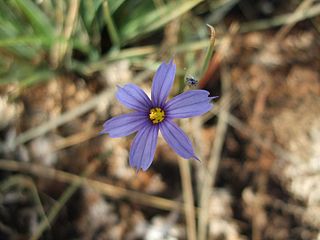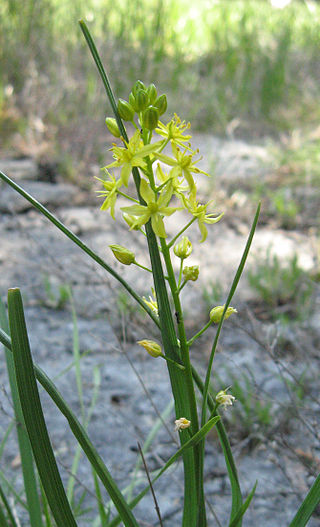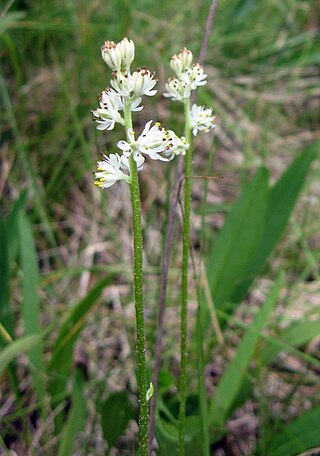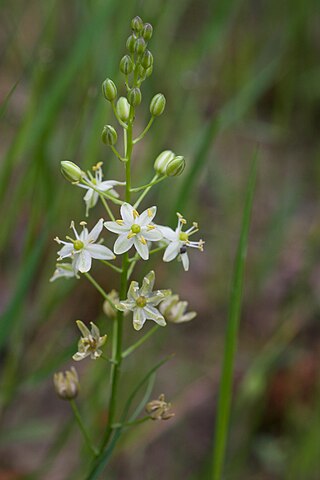
Pinus echinata, the shortleaf pine, is a species of pine native to the Southeastern United States and Midwestern United States.

Claytonia virginica, the Virginia springbeauty, eastern spring beauty, grass-flower or fairy spud, is an herbaceous perennial plant in the family Montiaceae. Its native range is eastern North America. Its scientific name honors Colonial Virginian botanist John Clayton (1694–1773).

Eriogonum longifolium var. harperi, also known as Harper's buckwheat or Harper's umbrella plant, is a dicot of the family Polygonaceae, found in areas of nutrient-poor shale soils in Alabama, Kentucky and Tennessee. It lives inconspicuously in an immature vegetative stage for four or more years before developing a flowering stalk, then flowers and dies. It is listed as an endangered species by the state of Tennessee. It has eleven small populations in Alabama and five in Tennessee but its survival in Kentucky is uncertain. According to a leading expert, Professor James L. Reveal of the University of Maryland, its Kentucky population has been reportedly extirpated. Its 2006 Alabama Natural Heritage Program ranking was G4T2S1, demonstrating an opinion that it was "critically imperiled" in that state.

Platanthera blephariglottis, commonly known as the white fringed orchid or white-fringed orchis, is a species of orchid of the genus Platanthera. It is considered to be an endangered species in Connecticut and Ohio, a threatened species in Florida, Maryland and Rhode Island, exploitably vulnerable in New York, and susceptible to be threatened in Québec.

Coreopsis rosea is a North American species of Coreopsis in the family Asteraceae. It has a discontinuous distribution in the eastern United States and Canada, found in Nova Scotia, Massachusetts, Rhode Island, New York, New Jersey, Pennsylvania, Delaware, Maryland, Georgia, and South Carolina.

Solidago rugosa, commonly called the wrinkleleaf goldenrod or rough-stemmed goldenrod, is a species of flowering plant in the family Asteraceae. It is native to North America, where it is widespread across eastern and central Canada and the eastern and central United States. It is usually found in wet to mesic habitats.

Ranunculus pusillus, commonly called low spearwort, is a species of flowering plant in the buttercup family (Ranunculaceae). It is native to much of the eastern United States from New York to Florida and west to Texas; it is also known in California. It grows in wet habitat, where it is semi-aquatic growing partially submerged or terrestrially on muddy substrates.

Senecio sylvaticus is a species of flowering plant in the aster family. It is variously known as the woodland ragwort, heath groundsel, or mountain common groundsel. It is native to Eurasia, and it can be found in other places, including western and eastern sections of North America, as an introduced species and an occasional roadside weed. It grows best in cool, wet areas. It is an annual herb producing a single erect stem up to 80 centimeters tall from a taproot. It is coated in short, curly hairs. The toothed, deeply lobed leaves are up to 12 centimeters long and borne on petioles. They are evenly distributed along the stem. The inflorescence is a wide, spreading array of many flower heads, each lined with green- or black-tipped phyllaries. The heads contain yellow disc florets and most have very tiny yellow ray florets as well.

Sisyrinchium funereum is an uncommon species of flowering plant in the family Iridaceae known by the common names Funeral Mountain blue-eyed grass and Death Valley blue-eyed-grass. It is endemic to the Mojave Desert of the United States, where it is known only from the Funeral Mountains and Death Valley area in eastern California, and the Ash Meadows area just over the border in Nevada. It grows in wet, highly alkaline habitat, such as seeps and mineral springs.

Decumaria barbara, commonly called climbing hydrangea or woodvamp, is a species plant in the Hydrangea family. It is native to southeastern United States, where it is widespread. Its typical natural habitat is wet bottomland forest, although it is also found in rich mesic forests in the Appalachian Mountains.

Bidens aristosa is a North American species of plants in the sunflower family. Common names include bearded beggarticks, western tickseed, long-bracted beggarticks, tickseed beggarticks, swamp marigold, and Yankee lice. It is native to eastern and central United States and south-central Canada, from Maine south to Florida and west as far as Ontario, Texas, and Nebraska. It grows in wet meadows and abandoned fields.

Schoenolirion, rush-lily or sunnybell, is a genus of three recognized species of flowering plants, all endemic to the southeastern United States. In the APG III classification system, the genus is placed in the family Asparagaceae, subfamily Agavoideae.
Solidago verna is a species of flowering plant in the aster family known by the common names springflowering goldenrod and spring goldenrod. It is native to North Carolina and South Carolina in the United States.

Triantha glutinosa is a species of flowering plant in the Tofieldiaceae family. It is commonly known as the sticky false asphodel, sticky tofieldia or northern bog asphodel, is a species of flowering plant in the tofieldia family.
Hypericum galioides, the bedstraw St. Johnswort, is a species of flowering plant in the St. John's wort family, Hypericaceae. It is endemic to the Southeastern United States.

Hypericum tetrapetalum, the fourpetal St. Johnswort, is a species of flowering plant in the St. John's wort family, Hypericaceae. It is found in the Southeastern United States and Cuba. It was first described by Jean-Baptiste Lamarck in 1797.

Schoenolirion wrightii, known as Texas sunnybell, is a species of flowering plant in the Agave subfamily. It is native to the southern United States, in Texas, Louisiana, Arkansas, and Alabama. Texas sunnybell produces vertical rootstocks topped with prominent bulbs, each up to 17 mm (0.67 in) in diameter. Between two and seven leaves are produced per plant, up to 34 cm (13 in) long and only 6 mm (0.24 in) across each, flattened to slightly keeled and usually shorter than the flowerhead. The ovate to lanceolate tepals are white with a green stripe on the back, mostly three-veined, but sometimes five-veined. Schoenolirion wrightii flowers between March and May, occurring in sandstone outcrops, wet pinelands, and boggy places.
Hypericum myrtifolium, the myrtleleaf St. Johnswort, is a species of flowering plant in the St. John's wort family, Hypericaceae. It is endemic to the Southeastern United States. It was first described by Jean-Baptiste Lamarck in 1797.

Hypericum fasciculatum, known as peelbark St. Johnswort or sandweed, is a species of flowering plant in the St. Johnswort family, Hypericaceae, native to the southeastern United States. It is found from eastern North Carolina, south to southern Florida, west to eastern Louisiana. Kew's Plants of the World Online database also notes that it occurs in Cuba, though Cuba is not listed in several other sources. It was first described in 1797 by Jean-Baptiste Lamarck.

Hypericum lobocarpum, commonly called fivelobe St. Johnswort, is a species of flowering plant in the St. Johnswort family (Hypericaceae). It is native eastern to North America, where it is found primarily in the western portion of the southeastern United States. Its typical natural habitat is in open wet areas, such as stream banks, lake margins, swamps, and pine savannas.
















